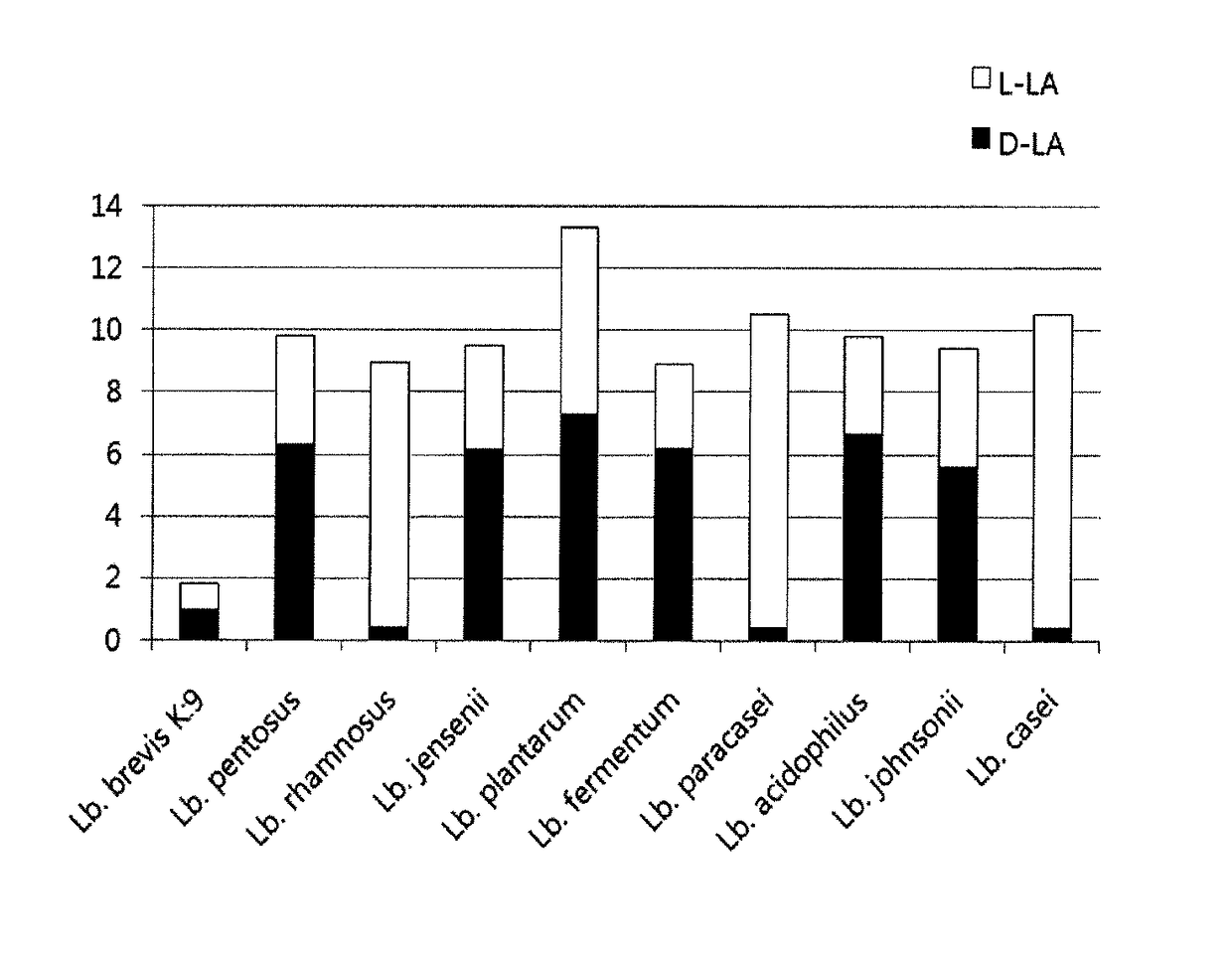D-lactic acid-producing strain and use thereof
a technology of d-lactic acid and producing strain, which is applied in the field of new d-lactic acid-producing strains, can solve the problems of limited application, inability to control the composition ratio of d-lactic acid and l-lactic acid, and inability to control the lactic acid composition ratio, etc., and achieve the effect of enhancing the activity of d-lactate dehydrogenas
- Summary
- Abstract
- Description
- Claims
- Application Information
AI Technical Summary
Benefits of technology
Problems solved by technology
Method used
Image
Examples
example 2
n of Nucleotide Sequences of L-Lactate Dehydrogenase (L-LDH)
[0043]To delete a gene inducing overproduction of L-lactic acid in each of the strains selected in Example 1, homology between L-LDH-encoding gene of the selected strains was compared and analyzed by searching U.S. National Center for Biotechnology Information (NCBI) (www.ncbi.nlm.nih.gov) (Table 1).
[0044]
TABLE 1Homology comparision between L-LDH gene of Lactobacillusparacasei and homologous genesHomology with ldh ofHomology with ldh1 ofLactobacillus casei ldh1 100%Lactobacillus casei ldh2 99%Lactobacillus rhamnosus ldhLactobacillus rhamnosus ldh(LGG_02523) 91%(LGG_00606) 79%
[0045]As shown in Table 1, the L-LDH-encoding genes of 3 types of lactic acid-producing strains have very similar nucleotide sequences to each other, and in particular, ldh1 of Lactobacillus casei is known as an important L-lactic acid-producing gene (J. Ind. Microbiotechnol., 2008, 35:579-586). Meanwhile, ldh2 of Lactobacillus casei is another L-lactic...
example 3
ion of L-LDH-Deletion / D-LDH-Insertion Vectors
[0046]Vectors for deletions of the L-LDH genes of Lactobacillus paracasei, Lactobacillus casei and Lactobacillus rhamnosus, which were selected in Example 2, were prepared. In order to prepare a cassette for deleting L-LDH and inserting D-LDH at the same time, sequences adjacent to ORF of ldh and ldh1 of Lactobacillus paracasei, ldh1 and ldh2 of Lactobacillus casei, and LGG02523 and LGG00606 of Lactobacillus rhamnosus were used as homologous nucleotide sequence, and primers of SEQ ID NOs. 1 to 24 were prepared (Table 2).
[0047]
TABLE 2Nucleotide sequence of primerSEQ IDNucleotideNO:sequence (5′-3′)Template1atatgcctcgagcgggatttcLb. paracasei,ctaggccaacaatcatLb. casei2ttgcgtaagcaaaaattttagLb. paracasei,tcatggtgatatcatcctttcLb. caseittatgtgc3gcacataagaaaggatgatatLb. delbrueckiicaccatgactaaaatttttgcttacgcaa4tggttgcttacttatcagtgaLb. delbrueckiitcgtgatgattagccaaccttaactggagtttca5tgaaactccagttaaggttggLb. paracasei,ctaatcatcacgatcactgatLb. caseiaag...
example 4
on of Transformants
[0057]Lactobacillus paracasei, Lactobacillus casei or Lactobacillus rhamnosus strains cultured in MRS solid media for one day were inoculated in 10 ml of MRS media, followed by stationary culture at 37° C. for one day. 50 ml of MRS was put in 50 ml of tube, and 500 μl of each strain cultured for one day was inoculated thereto, followed by stationary culture at 37° C. for 3 hours and 30 minutes. When OD600 reached 0.8, the culture broths were placed in an ice bath for 5 minutes. Thereafter, the media were removed from the culture broths by centrifugation to obtain the only strains. The strains were washed with a washing buffer (5 mM sodium phosphate, 1 mM MgCl2, pH 7.4) twice. Subsequently, 25 μl of 0.5 M sucrose solution was added to the strains, followed by suspension. Each 50 μl thereof was dispensed. Each 200 ng of the vectors prepared in Examples 3 were added to the strains, followed by electroporation under the conditions of 1800 v, 25 F and 200Ω. Thereafter,...
PUM
| Property | Measurement | Unit |
|---|---|---|
| molecular weight | aaaaa | aaaaa |
| temperature | aaaaa | aaaaa |
| concentration | aaaaa | aaaaa |
Abstract
Description
Claims
Application Information
 Login to View More
Login to View More - R&D
- Intellectual Property
- Life Sciences
- Materials
- Tech Scout
- Unparalleled Data Quality
- Higher Quality Content
- 60% Fewer Hallucinations
Browse by: Latest US Patents, China's latest patents, Technical Efficacy Thesaurus, Application Domain, Technology Topic, Popular Technical Reports.
© 2025 PatSnap. All rights reserved.Legal|Privacy policy|Modern Slavery Act Transparency Statement|Sitemap|About US| Contact US: help@patsnap.com

